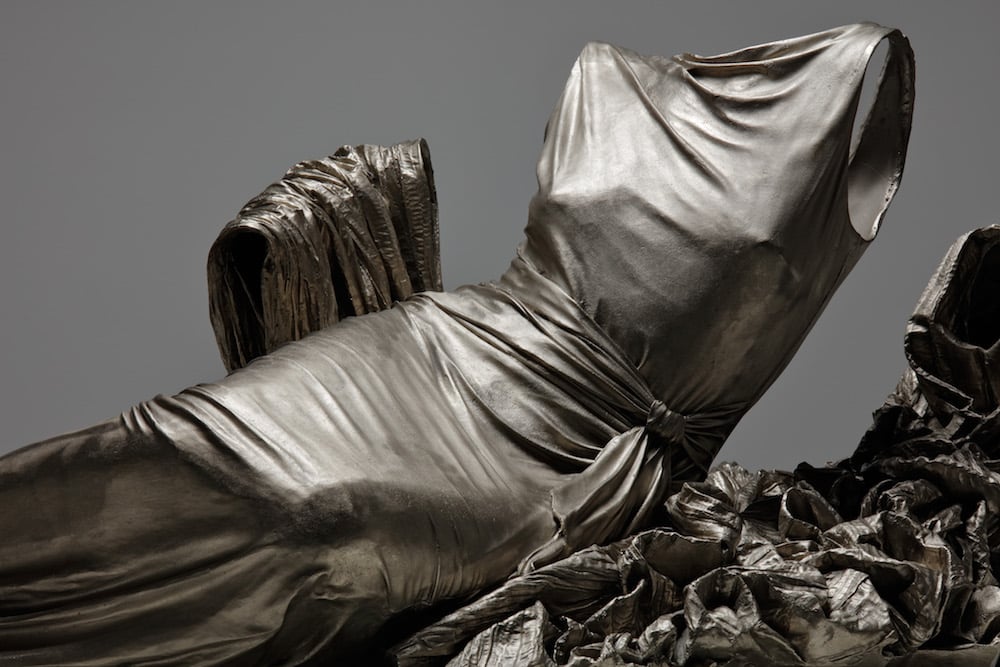Sustainability
How Can an Artist Making Weighty Work Go Carbon Negative? Karen LaMonte Has a Blueprint (It’s Cheaper Than You Think)
She quickly learned that not all carbon offsets are created equal.

She quickly learned that not all carbon offsets are created equal.

Eileen Kinsella

When Karen LaMonte learned a surprising fact about clouds, it changed everything.
The Prague-based artist, who is best known for creating life-size sculptures of ghostly gowns, was in the process of doing research on clouds for a new body of work. When she learned that a cumulus cloud could weigh 220 tons (“I thought, honestly how is that even possible?”), it set off a chain of inquiries that ultimately inspired her to become entirely carbon negative.
As she worked to develop a cloud sculpture that had the same weight as the water weight of a cloud, she began speaking with two climatologists who explained that low-lying cumulus clouds play a major role in cooling the Earth—and that they may be going extinct.
Such clouds cover about 60 percent of the Earth’s oceans and reflect sunlight, keeping the Earth cooler. Due to increased levels of carbon dioxide in the atmosphere, the “circumstances that are necessary for [these clouds] to form are going away,” LaMonte told Artnet News.
“I couldn’t be exposed to that and not take a very active step,” she said. So in addition to already recycling all materials in her studio, she began to delve into the complex world of carbon offsets. “Originally I thought I would plant a huge number of trees, and it turns out that that’s not actually effective,” LaMonte said.
Research about offset programs led LaMonte to a nonprofit called Cool Effect, which identifies and promotes scientifically verified projects that offset carbon “that would not be offset in any other way,” she explained.

Karen LaMonte, Reclining Nocturne 3, (2015). Image courtesy Gerald Peters Gallery.
But first, she had to calculate her own footprint. Meticulous record-keeping over the years proved a boon. “During the 20-some odd years that I’ve been making things, I kept very good records of the amount of metal I’ve cast, the amount of glass I’ve cast, and all the materials I’ve used,” she said.
Using a carbon calculator, she was able to “very accurately asses how much carbon my entire artistic output has generated. Then I added my travel and the travel of the sculptures. I took that number and doubled it.” Why? “I figure if I made a mistake—if I missed something—I just want to be 100 percent sure,” she said.
After she calculated the amount she needed to offset, she directed that sum toward two initiatives associated with Cool Effect. The first provides cook stoves for families in Uganda as an alternative to cooking over open wood fires, a big carbon producer. (The provided stoves reduce by at least half the amount of fuel that needs to be burned.)
The second involves “biodigestors” in an area in the Sichuan region of China that is heavily reliant on pig farming and thus yields high levels of methane. (Methane is five times worse for the environment than carbon dioxide, LaMonte said.) The biodigestors are used to compost the pigs’ and other waste.
Having already retraced the past 20 years of her career, LaMonte plans to do the carbon calculation on an annual basis going forward. For anyone thinking about following in her footsteps, she estimates the cost is about $1,000 annually.
“I think that’s a very reasonable number to be able to continue making my work in a sustainable and thoughtful way. It just seems do-able,” she said. When people ask if she considers herself an activist, she says she prefers the term “activator.”
“I’m hugely inspired to be an artist and I want to do it in a sustainable way,” she said. “I don’t want to give it up or feel guilty about it. So I decided to just take the bull by the horns and deal with it. For all of us earthlings, every day is Earth Day.”